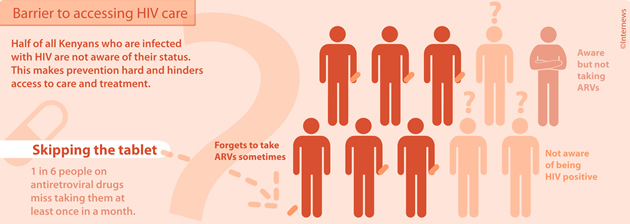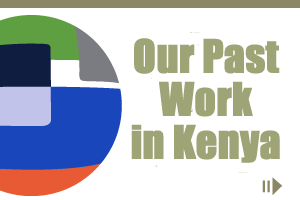By Ida Jooste
Some of us have never known a world without HIV. Some of us remember the shockwaves of dread, the frenzy to try to fathom it, the shudders and whispers of shame.
It is the media that brought HIV into our homes – 30 years ago. It was called “slim disease”, because of the dramatic weight loss. And the images of skeletal human frames confirmed it was something to best run away from. The first specialists to attend to HIV patients were skin doctors, because skin cancer is a common opportunistic infection. Dermatologist at the Aga Khan University hospital Dr D.M. Owili recalls how, in 1984, he sent blood samples of a patient with severe skin lacerations and swelling to the US. A month later the results came back: HIV positive. The tests weren’t done anywhere in Africa then. Now, rapid HIV tests are widely available in Kenya and results are ready in 10 minutes. Looking back, we forget how little we knew about HIV then. One of the best ways to look back is to track how journalists tried to make sense of it - and this is how #HIV30Kenya came about. “We scoured almost 10,000 media articles from The Nation Media Group’s archives and from the Internews HIV news clippings library,” says Dorothy Otieno, Internews data journalism trainer, who stumbled on the fact that Kenya’s first HIV case was diagnosed 30 years ago in the course of data analysis. The result: an interactive 3D timeline, #HIV30Kenya that explores media coverage of the HIV epidemic in Kenya over time and visualises key milestones along the way. What do we learn from it? Tracking HIV news is a journey from horror to hope. But it is more complex than that.
Three years before Kenya’s first HIV case, major national newspapers like the New York Times in the US and the Nation in Kenya report on a rare type of cancer found in gay men but the story quickly fades from the limelight. In 1985, front page headlines splash: “Killer sex disease in Kenya”, and “Horror sex disease in Kakamega”. In 1986, we see denial: “HIV not common in Kenya” and in 1989, Joe Muriuki becomes the first Kenyan to go public about his HIV status. Images of severely sick, thin, and unhealthy HIV positive people accompany the increasing HIV coverage in the media in the late 1980s and early 1990s. The message: one can tell an HIV positive person by looking at them. In 1998 President Moi declares Aids a national disaster. We start seeing news reports of hope, in the form of vaccine trials and success in the West with antiretroviral therapy. President Kibaki, declares ‘Total War on AIDS’ in 2002. The church calls for abstinence. The media stories start to hint at hope and solutions in science. Journalists, meanwhile, become skilled at talking about the many facets of a wily virus, the most intensely studied microbe in human history, because it attacks the very system that protects us from disease. HIV forces us to talk about sex publically and challenges us to think differently about taboos like sex work, men who have sex with men and intravenous drug users.
“Towards the latter part of the 30 years timeline, journalists have become skilled at explaining complex science like how HIV treatment drugs can be used to prevent HIV infection,” says Dr Nicholas Muraguri the Director of Medical Services in the Ministry of Health. “From our analysis of key words used in media articles in The Nation, the last four years focused on the increased action on the policy front and there were also stories reinforcing that HIV is no longer a death sentence,” says Otieno. But the stories also show how stigma and discrimination still hinder access to prevention, treatment and care services. “Progress, but there are still some major gaps,” says Dr Nduku Kilonzo, Director of the National Aids Control Council, “We want to look forward to zero new infections and zero deaths from HIV related illnesses, but it can only happen if there is zero stigma and discrimination.”
HIV has been with us for 30 years in Kenya and our understanding has been transformed in this time. In other parts of Africa, journalists are already using the HIV experience to learn how to communicate about Ebola in ways that do away with myths and prevent disease. But three decades is little time in the history of a virus. What story will the media be writing in another 30 years’ time?
Photo essays on overcoming HIV stigma accompany the launch of #HIV30Kenya. These can be seen for the month of December at the National Museums of Kenya in Nairobi.
Kenya’s largest circulation newspaper, The Nation, whose archives helped create #HIV30Kenya hosted the platform on its online news site.




